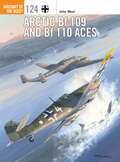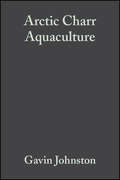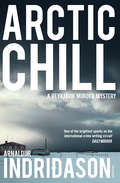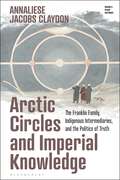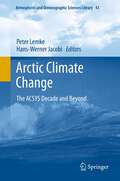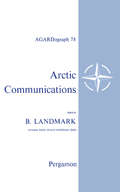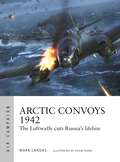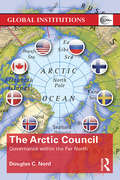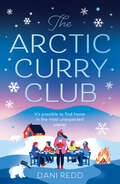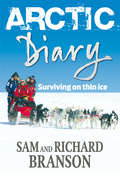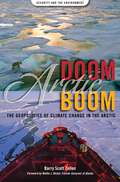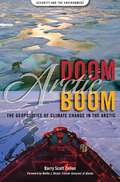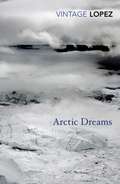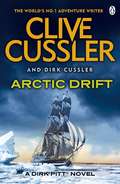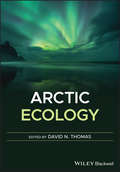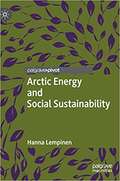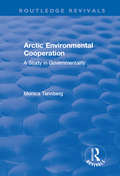- Table View
- List View
Arctic Bf 109 and Bf 110 Aces (Aircraft of the Aces)
by John Weal Chris Davey Mark PostlethwaiteOnce Nazi Germany had conquered Norway in 1940, just a handful of Gruppen flying the Bf 109 and Bf 110 fighters were able to shatter all opposition and dominate the air in the Arctic Circle. Yet as the dual threats of the RAF and the Red Air Force grew, the Luftwaffe was forced to increase its fighter presence to full Geschwader strength with the formation of JG 5 Eismeer (Ice-sea) in early 1942.The struggle for the frozen skies of the arctic raged on until the end of the war as the embattled JG 5 produced some of the Eastern Front's leading aces, pilots of the calibre of Theodor Weissenberger, Heinrich Ehrler, Walter Schuck, Franz Dörr and Jakob Norz all achieving over 100 kills. Featuring first-hand accounts from the pilots, extensive research from a leading authority on the Luftwaffe, and illustrations of the aircraft in unique winter camouflage, this book is a comprehensive guide to the Arctic Experten and the planes they flew.
Arctic Charr Aquaculture
by Gavin JohnstonThis important book draws together, for the first time, a vast wealth of information on all major aspects of the farming of Arctic charr, a highly prized and commercially valuable salmonid. The author, Gavin Johnston who has many years' experience of farming Arctic charr, teaching about and researching the species, has produced a book that is a landmark publication and an essential purchase for all those involved with the species. The book is broadly divided into three sections. The first section covers Arctic charr interactions with humans and the charr's biological requirements for culture. Section two is a practical guide to the art and science of early-rearing Arctic charr; a hands on application of current knowledge in Arctic charr aquaculture. The final section of the book focuses on the commercial production of Arctic charr, providing cutting-edge information for all those involved in the exploitation of this valuable species. Arctic Charr Aquaculture is an essential purchase for anyone involved in, or considering involvement in farming of this species. Farm managers and other personnel in fish farms and experimental aquaculture units, fish and aquatic biologists will find a huge amount of useful data in this book. Libraries in all university departments and research establishments where aquaculture, fisheries and fish biology are studies and taught should have copies of this book on their shelves. This book brings together for the first time the knowledge needed to farm and market Arctic Charr. Part One is an overview of Arctic Charr aquaculture beginning with the history and development of Charr aquaculture, the biological attributes of Arctic Charr, the physical requirements for growth and commercial production requirements. Other chapters are devoted to Charr health, nutrition and feeding. Part Two is a practical guide for the producer operating an Arctic Charr farm either as a vertically integrated operation or as discrete hatcheries and grow out farms. Part Three is devoted to the business of commercially producing Arctic Charr, and although it deals specifically with Charr it also covers many business aspects of farming relevant to any fish species under cold water cultivation. It covers farm business management, the economics and finance of Arctic Charr farming, marketing Charr products and a closing section on how to avoid the pitfalls which others including the author have experienced.
Arctic Chill (Inspector Erlendur Ser.)
by Arnaldur Indridason Bernard Scudder Victoria CribbA dark-skinned young boy is found dead, frozen to the ground in a pool of his own blood. The boy's Thai half-brother is missing; is he implicated, or simply afraid for his own life? While fears increase that the murder could have been racially motivated, the police receive reports that a suspected paedophile has been spotted in the area.Detective Erlendur's investigation soon unearths the tension simmering beneath the surface of Iceland's outwardly liberal, multi-cultural society while the murder forces Erlendur to confront the tragedy in his own past.
Arctic Circles and Imperial Knowledge: The Franklin Family, Indigenous Intermediaries, and the Politics of Truth (Empire’s Other Histories)
by Annaliese Jacobs ClaydonIn 1845 an expedition led by Sir John Franklin vanished in the Canadian Arctic. The enduring obsession with the Franklin mystery, and in particular Inuit information about its fate, is partly due to the ways in which information was circulated in these imperial spaces. This book examines how the Franklins and other explorer families engaged in science, exploration and the exchange of information in the early to mid-19th century. It follows the Franklins from the Arctic to Van Diemen's Land, charting how they worked with intermediaries, imperial humanitarians and scientists, and shows how they used these experiences to claim a moral right to information. Arctic Circles and Imperial Knowledge shows how the indigenous peoples, translators, fur traders, whalers, convicts and sailors who explorer families relied upon for information were both indispensable and inconvenient to the Franklins. It reveals a deep entanglement of polar expedition with British imperialism, and shows how geographical knowledge intertwined with convict policy, humanitarianism, genocide and authority. In these imperial spaces families such as the Franklins negotiated their tenuous authority over knowledge to engage with the politics of truth and question the credibility and trustworthiness of those they sought to silence.
Arctic Circles and Imperial Knowledge: The Franklin Family, Indigenous Intermediaries, and the Politics of Truth (Empire’s Other Histories)
by Annaliese Jacobs ClaydonIn 1845 an expedition led by Sir John Franklin vanished in the Canadian Arctic. The enduring obsession with the Franklin mystery, and in particular Inuit information about its fate, is partly due to the ways in which information was circulated in these imperial spaces. This book examines how the Franklins and other explorer families engaged in science, exploration and the exchange of information in the early to mid-19th century. It follows the Franklins from the Arctic to Van Diemen's Land, charting how they worked with intermediaries, imperial humanitarians and scientists, and shows how they used these experiences to claim a moral right to information. Arctic Circles and Imperial Knowledge shows how the indigenous peoples, translators, fur traders, whalers, convicts and sailors who explorer families relied upon for information were both indispensable and inconvenient to the Franklins. It reveals a deep entanglement of polar expedition with British imperialism, and shows how geographical knowledge intertwined with convict policy, humanitarianism, genocide and authority. In these imperial spaces families such as the Franklins negotiated their tenuous authority over knowledge to engage with the politics of truth and question the credibility and trustworthiness of those they sought to silence.
Arctic Climate Change: The ACSYS Decade and Beyond (Atmospheric and Oceanographic Sciences Library #43)
by Peter Lemke and Hans-Werner JacobiThe Arctic is now experiencing some of the most rapid and severe climate change on earth. Over the next 100 years, climate change is expected to accelerate, contributing to major physical, ecological, social, and economic changes, many of which have already begun. Changes in arctic climate will also affect the rest of the world through increased global warming and rising sea levels.The volume addresses the following major topics:- Research results in observing aspects of the Arctic climate system and its processes across a range of time and space scales- Representation of cryospheric, atmospheric, and oceanic processes in models, including simulation of their interaction with coupled models - Our understanding of the role of the Arctic in the global climate system, its response to large-scale climate variations, and the processes involved.
Arctic Communications: Proceedings of the Eighth Meeting of the AGARD Ionospheric Research Committee, Athens, Greece, July 1963
by B. LandmarkArctic Communications is a compilation of the proceedings of the Eighth Meeting of the Ionospheric Research Committee of NATO's Advisory Group for Aeronautical Research and Development, held in Athens, Greece in July 1963. The meeting provided a forum for discussing advances in communications equipment used to conduct research in the Arctic and covered a wide range of topics such as the physical properties of the Arctic ionosphere; Arctic high-frequency communications; soundings and field strength measurements; and observations in the Arctic during nuclear tests. This book is comprised of 25 chapters and begins with a discussion on experimental studies of high latitude absorption phenomena, including auroral absorption, polar cap absorption, and sudden commencement absorption. Direct measurements of D-region electron densities during the absorption periods are also presented. Subsequent chapters focus on the ionospheric absorption of cosmic noise observed at geomagnetically conjugate points; ionospheric ionization produced by solar flares; military communication facilities in the Canadian Arctic; and radio noise problems in Arctic regions. Phase instabilities on a very-low-frequency transmission path passing through the auroral zone are also considered. This monograph will be of particular value to scientists and researchers with interest in the Arctic.
Arctic Convoys: Bletchley Park and the War for the Seas
by David KenyonAn incisive account of the Arctic convoys, and the essential role Bletchley Park and Special Intelligence played in Allied success Between 1941 and 1945, more than eight hundred shiploads of supplies were delivered to the Soviet Union protected by allied naval forces. Each journey was a battle against the elements, with turbulent seas, extreme cold, and the constant dread of torpedoes. These Arctic convoys have been mythologized as defenseless vessels at the mercy of deadly U-boats—but was this really the case? David Kenyon explores the story of the war in the Arctic, revealing that the contest was more evenly balanced that previously thought. Battles included major ship engagements, aircraft carriers, and combat between surface ships. Amid this wide range of forces, Bletchley Park’s Naval Section played a decisive role in Arctic operations, with both sides relying heavily on Signals Intelligence to intercept and break each other’s codes. Kenyon presents a vivid picture of the Arctic theater of war, unearthing the full-scale campaign for naval supremacy in northern waters.
Arctic Convoys 1942: The Luftwaffe cuts Russia's lifeline (Air Campaign)
by Mark LardasA new history of the most crucial few months of the Arctic Convoys, when Germany's air power forced the Allies to retreat to the cover of winter. Between spring and autumn 1942, Germany was winning the battle of the Arctic Convoys. Half of PQ-15 was sunk in May, PQ-17 was virtually obliterated in July, and in September 30 percent of PQ-18 was sunk. The Allies were forced to suspend the convoys until December, when the long Arctic nights would shield them.Mark Lardas argues that in 1942, it was Luftwaffe air power that made the difference. With convoys sailing in endless daylight, German strike aircraft now equipped and trained for torpedo attacks, and bases in northern Norway available, the Luftwaffe could wreak havoc. Three-quarters of the losses of PQ-18 were due to air attacks. But in November, the Luftwaffe was redeployed south to challenge the Allied landings in North Africa, and the advantage was lost. Despite that, the Allies never again sailed an Arctic convoy in the summer months.Fully illustrated with archive photos, striking new artwork, maps and diagrams, this is the remarkable history of the Luftwaffe's last strategic victory of World War II.
Arctic Convoys 1942: The Luftwaffe cuts Russia's lifeline (Air Campaign)
by Mark LardasA new history of the most crucial few months of the Arctic Convoys, when Germany's air power forced the Allies to retreat to the cover of winter. Between spring and autumn 1942, Germany was winning the battle of the Arctic Convoys. Half of PQ-15 was sunk in May, PQ-17 was virtually obliterated in July, and in September 30 percent of PQ-18 was sunk. The Allies were forced to suspend the convoys until December, when the long Arctic nights would shield them.Mark Lardas argues that in 1942, it was Luftwaffe air power that made the difference. With convoys sailing in endless daylight, German strike aircraft now equipped and trained for torpedo attacks, and bases in northern Norway available, the Luftwaffe could wreak havoc. Three-quarters of the losses of PQ-18 were due to air attacks. But in November, the Luftwaffe was redeployed south to challenge the Allied landings in North Africa, and the advantage was lost. Despite that, the Allies never again sailed an Arctic convoy in the summer months.Fully illustrated with archive photos, striking new artwork, maps and diagrams, this is the remarkable history of the Luftwaffe's last strategic victory of World War II.
The Arctic Council: Governance within the Far North (Global Institutions)
by Douglas C. NordThis book helps us to think carefully about how this area of the world should be best handled in the future by offering a concise and accessible introduction to the Arctic Council. Over the past two decades, the Arctic has evolved from being a remote region in international affairs to becoming an increasingly central concern of the global community. The issues of climate change, access to new energy resources, the development of new global trade routes, the protection of the natural environment and the preservation of indigenous cultures and languages have all come to be focused within this formerly neglected region. Now in its nineteenth year of operation the Arctic Council, an innovative international organization, is going through a period of new growth and challenges. This work identifies the major trends and directions of current Arctic diplomacy and the manner in which national, regional and international leaders and organizations can all make useful contributions in dealing with the complex agenda of environmental, economic and political challenges faced by this increasingly significant area of the globe. This book will be of great interest to students and scholars of international organizations, international relations and the environment.
The Arctic Council: Governance within the Far North (Global Institutions)
by Douglas C. NordThis book helps us to think carefully about how this area of the world should be best handled in the future by offering a concise and accessible introduction to the Arctic Council. Over the past two decades, the Arctic has evolved from being a remote region in international affairs to becoming an increasingly central concern of the global community. The issues of climate change, access to new energy resources, the development of new global trade routes, the protection of the natural environment and the preservation of indigenous cultures and languages have all come to be focused within this formerly neglected region. Now in its nineteenth year of operation the Arctic Council, an innovative international organization, is going through a period of new growth and challenges. This work identifies the major trends and directions of current Arctic diplomacy and the manner in which national, regional and international leaders and organizations can all make useful contributions in dealing with the complex agenda of environmental, economic and political challenges faced by this increasingly significant area of the globe. This book will be of great interest to students and scholars of international organizations, international relations and the environment.
The Arctic Council: Between Environmental Protection and Geopolitics
by Svein Vigeland RottemThis pivot introduces the Arctic Council and its role as a platform for dealing with local, national, regional and global challenges of relevance to the “new” Arctic. Against the backdrop of climate change and increasing commercial activity, it considers what a future Arctic should look like, from ideas of total protection to expansive oil and gas extraction. It examines the Arctic’s position on the political agenda, from Norway’s High North hype to a more peripheral place in the foreign policy of the US and explores the Council's role as an important international forum for dialogue and cooperation on Arctic challenges and opportunities, and a significant arena for developing knowledge and learning about a changing region.
The Arctic Curry Club
by Dani Redd‘For my whole life I had been looking for home. But why would that be in a place that I’d left? Perhaps I had to keep moving forward in order to find it…’
Arctic Diary: Surviving on thin ice
by Sir Richard Branson Sam BransonIt's hardly a surprise to discover that Sam Branson has a love of adventure and a real concern about our future in a world where the climate is changing rapidly. Journeying into the heart of the Arctic wilderness with his father and a film crew, Sam explores the changing landscape and the lives of the native Inuit people who have survived in a relentlessly inhospitable environment for 5000 years.Sleeping on frozen seas and encountering majestic polar bears, Sam and his father embark together on a winter expedition which Sam must ultimately complete on his own, finding new depths of resilience and courage in a formidable and breathtaking landscape.
Arctic Doom, Arctic Boom: The Geopolitics of Climate Change in the Arctic (Security and the Environment)
by Barry Scott ZellenAn expert examination of the way climate change is transforming the Arctic environmentally, economically, and geopolitically, and how the challenges of that transformation should be met.A growing number of scientists estimate that there will be no summer ice in the Arctic by as soon as 2013. Are we approaching the "End of the Arctic?" as journalist Ed Struzik asked in 1992, or fully entering the "Age of the Arctic," as Arctic expert Oran Young predicted in 1986? Arctic Doom, Arctic Boom: The Geopolitics of Climate Change in the Arctic looks at the uncertainty at the top of the world as the shrinking of the polar ice cap opens up new sea lanes and the vast hydrocarbon riches of the Arctic seafloor to commercial development and creates environmental disasters for Arctic biota and indigenous peoples. Arctic Doom, Arctic Boom explores the geopolitics of the Arctic from a historical as well as a contemporary perspective, showing how the warming of the Earth is transforming our very conception of the Arctic. In addition to addressing economic and environmental issues, the book also considers the vital strategic role of the region in our nation's defenses.
Arctic Doom, Arctic Boom: The Geopolitics of Climate Change in the Arctic (Security and the Environment)
by Dr. Barry Scott ZellenAn expert examination of the way climate change is transforming the Arctic environmentally, economically, and geopolitically, and how the challenges of that transformation should be met.A growing number of scientists estimate that there will be no summer ice in the Arctic by as soon as 2013. Are we approaching the "End of the Arctic?" as journalist Ed Struzik asked in 1992, or fully entering the "Age of the Arctic," as Arctic expert Oran Young predicted in 1986? Arctic Doom, Arctic Boom: The Geopolitics of Climate Change in the Arctic looks at the uncertainty at the top of the world as the shrinking of the polar ice cap opens up new sea lanes and the vast hydrocarbon riches of the Arctic seafloor to commercial development and creates environmental disasters for Arctic biota and indigenous peoples. Arctic Doom, Arctic Boom explores the geopolitics of the Arctic from a historical as well as a contemporary perspective, showing how the warming of the Earth is transforming our very conception of the Arctic. In addition to addressing economic and environmental issues, the book also considers the vital strategic role of the region in our nation's defenses.
Arctic Dreams: Imagination And Desire In A Northern Landscape (Picador Bks.)
by Barry LopezWITH AN INTRODUCTION BY ROBERT MACFARLANELopez’s journey across our frozen planet is a celebration of the Arctic in all its guises. A hostile landscape of ice, freezing oceans and dazzling skyscapes. Home to millions of diverse animals and people. The stage to massive migrations by land, sea and air. The setting of epic exploratory voyages. And, in crystalline prose, Lopez captures the magic of the Arctic – the essential mystery and beauty of a continent that has enchanted man’s imagination and ambition for centuries.
Arctic Drift: Dirk Pitt #20 (The Dirk Pitt Adventures #20)
by Clive Cussler Dirk CusslerArctic Drift sees Clive Cussler's greatest hero, Dirk Pitt, fighting his enemies in the cruel Arctic.A foundered Victorian ship looking for the fabled Northwest Passage holds a secret in its icy grave . . . When Dirk Pitt of NUMA is almost blown to pieces in a lab explosion, he suspects sabotage. The lab in question belongs to a scientist hoping to use a rare mineral to combat greenhouse gases - but who would want to destroy our one chance to save the planet?But there are those who will do anything to control such a valuable prize. Pitt's investigations take him to the Arctic in search of a clue to the origins of this precious mineral. There he and NUMA colleague Al Giordino must battle for survival against the hostile elements and an evil megalomaniac who is about to plunge the North American continent into war . . .Arctic Drift is a white-knuckle ride of a novel that once picked up you won't want to put down. It is the twentieth of Clive Cussler's bestselling Dirk Pitt novels - the series that also includes Raise the Titanic!and his first novel, Mayday - and is co-authored with his son Dirk Cussler. Praise for Clive Cussler: 'Clive Cussler is hard to beat' Daily Mail
Arctic Drift: Dirk Pitt #20 (Dirk Pitt Adventures #20)
by Clive Cussler Dirk CusslerA foundered Victorian ship looking for the fabled Northwest Passage holds a secret in its icy grave . . .When Dirk Pitt of NUMA is almost blown to pieces in a lab explosion, he suspects sabotage. The lab in question belongs to a scientist hoping to use a rare mineral to combat greenhouse gases - but who would want to destroy our one chance to save the planet?But there are those who will do anything to control such a valuable prize. Pitt's investigations take him to the Arctic in search of a clue to the origins of this precious mineral. There he and NUMA colleague Al Giordino must battle for survival against the hostile elements and an evil megalomaniac who is about to plunge the North American continent into war . . .Arctic Drift is a white-knuckle ride of a novel that sees Clive Cussler's greatest hero, Dirk Pitt, fighting his enemies in the cruel Arctic.Praise for Clive Cussler'Clive Cussler is hard to beat' Daily Mail'Clive Cussler is the guy I read' Tom Clancy'The Adventure King' Daily Express
Arctic Ecology
by David N. ThomasThe Arctic is often portrayed as being isolated, but the reality is that the connectivity with the rest of the planet is huge, be it through weather patterns, global ocean circulation, and large-scale migration patterns to name but a few. There is a huge amount of public interest in the ‘changing Arctic’, especially in terms of the rapid changes taking place in ecosystems and exploitation of resources. There can be no doubt that the Arctic is at the forefront of the international environmental science agenda, both from a scientific aspect, and also from a policy/environmental management perspective. This book aims to stimulate a wide audience to think about the Arctic by highlighting the remarkable breadth of what it means to study its ecology. Arctic Ecology seeks to systematically introduce the diverse array of ecologies within the Arctic region. As the Arctic rapidly changes, understanding the fundamental ecology underpinning the Arctic is paramount to understanding the consequences of what such change will inevitably bring about. Arctic Ecology is designed to provide graduate students of environmental science, ecology and climate change with a source where Arctic ecology is addressed specifically, with issues due to climate change clearly discussed. It will also be of use to policy-makers, researchers and international agencies who are focusing on ecological issues and effects of global climate change in the Arctic. About the Editor David N. Thomas is Professor of Arctic Ecosystem Research in the Faculty of Biological and Environmental Sciences, University of Helsinki. Previously he spent 24 years in the School of Ocean Sciences, Bangor University, Wales. He studies marine systems, with a particular emphasis on sea ice and land-coast interactions in the Arctic and Southern Oceans as well as the Baltic Sea. He also edited a related book: Sea Ice, 3rd Edition (2017), which is also published by Wiley-Blackwell.
Arctic Ecology
by David N. ThomasThe Arctic is often portrayed as being isolated, but the reality is that the connectivity with the rest of the planet is huge, be it through weather patterns, global ocean circulation, and large-scale migration patterns to name but a few. There is a huge amount of public interest in the ‘changing Arctic’, especially in terms of the rapid changes taking place in ecosystems and exploitation of resources. There can be no doubt that the Arctic is at the forefront of the international environmental science agenda, both from a scientific aspect, and also from a policy/environmental management perspective. This book aims to stimulate a wide audience to think about the Arctic by highlighting the remarkable breadth of what it means to study its ecology. Arctic Ecology seeks to systematically introduce the diverse array of ecologies within the Arctic region. As the Arctic rapidly changes, understanding the fundamental ecology underpinning the Arctic is paramount to understanding the consequences of what such change will inevitably bring about. Arctic Ecology is designed to provide graduate students of environmental science, ecology and climate change with a source where Arctic ecology is addressed specifically, with issues due to climate change clearly discussed. It will also be of use to policy-makers, researchers and international agencies who are focusing on ecological issues and effects of global climate change in the Arctic. About the Editor David N. Thomas is Professor of Arctic Ecosystem Research in the Faculty of Biological and Environmental Sciences, University of Helsinki. Previously he spent 24 years in the School of Ocean Sciences, Bangor University, Wales. He studies marine systems, with a particular emphasis on sea ice and land-coast interactions in the Arctic and Southern Oceans as well as the Baltic Sea. He also edited a related book: Sea Ice, 3rd Edition (2017), which is also published by Wiley-Blackwell.
Arctic Energy and Social Sustainability
by Hanna LempinenIn recent years the Arctic has become the focus of political, popular and scholarly debates around the future of our world’s Energy. Increasing consumption, dwindling reserves, climate warming and developing technologies are expected to push energy-related activities ever further into the previously inaccessible north. Within this framework, energy in the Arctic is predominantly understood as synonymous with oil and gas production for international exports; meanwhile, any social sustainability concerns associated with energy-related developments remain largely neglected or reduced to regional socioeconomic concerns.Lempinen adopts an alternative approach, exploring how energy and its societal aspects are defined and debated in the context of the circumpolar north. Combining an in-depth conceptual discussion on energy and the social dimension of sustainability with an empirical focus on the scientific and political “truths” produced about energy and society in the Arctic energyscape, this book is an enlightening read for students, scholars and professionals interested in issues related to energy and society in the Arctic or beyond.
Arctic Environmental Cooperation: A Study in Governmentality
by Monica TennbergThis title was first published in 2000: The book analyses the development of arctic environmental cooperation since the late 1980s until the establishment of the Arctic Council in 1996. The study is based on the discourse analysis of statement, documents and interviews by the different actors in the cooperation. In this book, the problem of the environment is seen as a problem of order: it is a problem of ordering relations among related actors, of ordering priorities of action and of ordering relations between different institutional arrangements locally, regionally and internally. Three discourses were found in the cooperation: discourses of sovereignty, knowledge and development. In the discourse of sovereignty, the development of relations between state and indigenous peoples in terms of international environmental cooperation is central. In the discourse of knowledge, the different forms of knowledge and the role of different producers of knowledge in cooperation has been discussed. The discourse of development focuses on the idea of sustainable development and its applications in defining the future of the Circumpolar North and the activities of the Arctic Council. The arctic cooperation can be understood as a regional effort to make an order of sustainability into practice.
Arctic Environmental Cooperation: A Study in Governmentality
by Monica TennbergThis title was first published in 2000: The book analyses the development of arctic environmental cooperation since the late 1980s until the establishment of the Arctic Council in 1996. The study is based on the discourse analysis of statement, documents and interviews by the different actors in the cooperation. In this book, the problem of the environment is seen as a problem of order: it is a problem of ordering relations among related actors, of ordering priorities of action and of ordering relations between different institutional arrangements locally, regionally and internally. Three discourses were found in the cooperation: discourses of sovereignty, knowledge and development. In the discourse of sovereignty, the development of relations between state and indigenous peoples in terms of international environmental cooperation is central. In the discourse of knowledge, the different forms of knowledge and the role of different producers of knowledge in cooperation has been discussed. The discourse of development focuses on the idea of sustainable development and its applications in defining the future of the Circumpolar North and the activities of the Arctic Council. The arctic cooperation can be understood as a regional effort to make an order of sustainability into practice.
